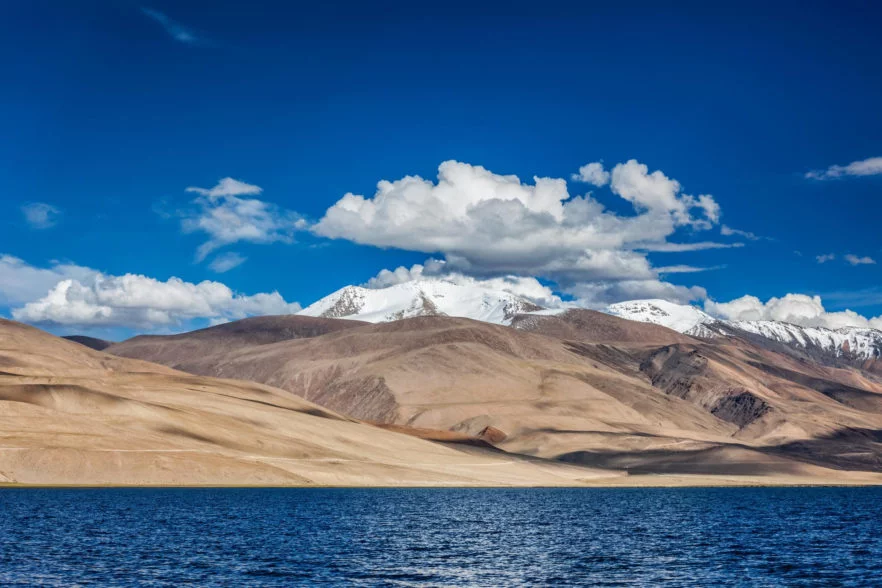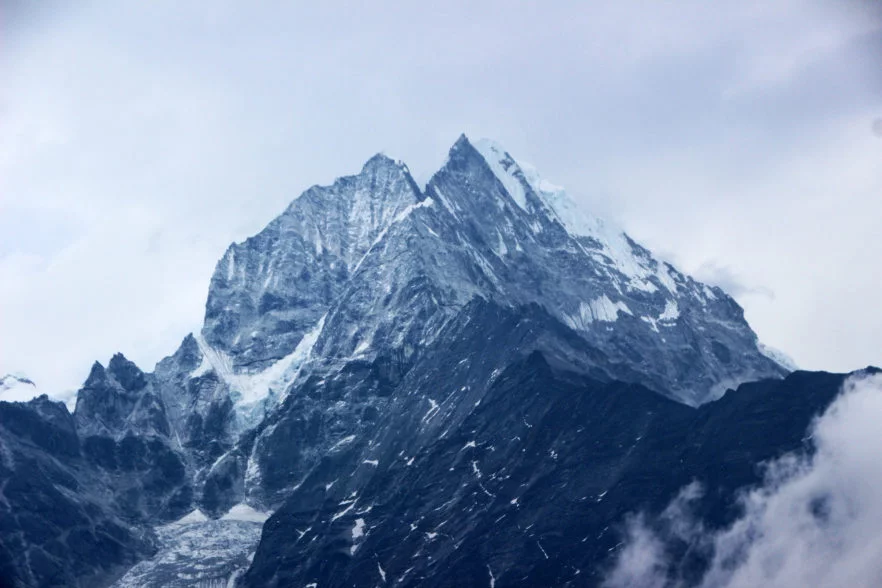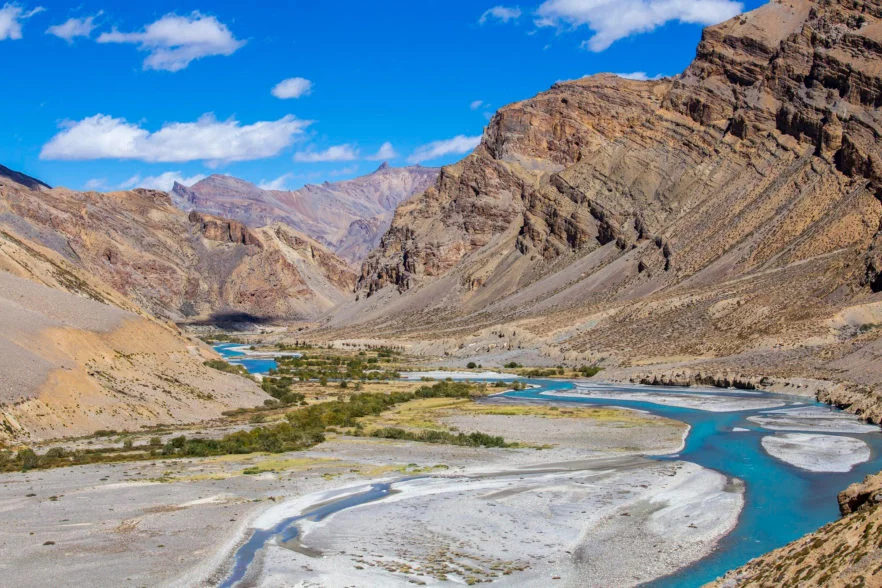The Himalayas: Mighty, Majestic, and Abundant
By Reina Esser
A vast mountain range that extends through Afghanistan, Pakistan, India, Tibet, Nepal, and Bhutan. Spanning across northeastern India lies the majestic Himalayas. The Sanskrit name Himalaya can be translated to mean “abode of snow,” Many of its peaks are exalted throughout Hinduism and Buddhism, making climbing and recreation forbidden.
Although the Himalayas rival the world’s largest mountain ranges, they are the youngest mountain formation on the planet. The formation of the Himalayas is believed to be the outcome of a landmass collision between India and Eurasia that was driven by the movement of tectonic plates around 40 to 50 million years ago.
According to geologists, the Himalayas continue to grow in height, approximately one centimeter per year. This is due to India’s continued movement north towards Asia. This movement is observed by earthquakes in the region. However, weather and erosion are significant factors to be considered and cause the Himalayas to lower around the same rate they are growing.
Home of The World’s Tallest Peaks
You’ve likely heard of Mount Everest, but did you know that the Himalayas house 10 out of 14 of the world’s tallest mountains? All 14 of these mountains boast a height of more than 8,000 meters or about 26,000 feet. The Himalayas graciously shares this accomplishment with four peaks of the Karakoram Mountain range, which extends across Pakistan and China.
Mount Everest is the tallest mountain in the world, right behind Mauna Kea, a dormant volcano in Hawaii that is partially submerged underwater. The total elevation of Mountain Everest is 29,032 feet. The feat of climbing this mountain attracts thousands of tourists to its location along the Nepal-China border. The first successful summit of this mountain was in 1953 by Tenzing Norgay, a Nepali Sherpa, and Edmond Hillary, a climber from New Zealand.
The second largest mountain peak across the Himalayas is Kangchenjunga, with an elevation of 28,169 feet. In 2021, Nims Puja, a Nepali Mountaineer, and his team of nine other Nepali mountaineers underwent a mission entitled “Project Possible” to summit 14 of the world’s tallest peaks in just seven months. The summit of Kangchenjunga took the team 18 hours, and during the descent, the team discovered a lost Indian climber named Chin Wui Kin, who had been without water or oxygen for 43 hours. The Nepali climbers shared oxygen and successfully executed a rescue by helicopter. Kin died in the hospital due to his injuries, but the story has quickly become a heroic tale worldwide and within the mountaineering community.
The eight other record-holding peaks of the Himalayas are:
- Lhotse – 27,940 Feet
- Makalu – 27, 825 Feet
- Cho Oyu – 26,864 Feet
- Dhaulagiri – 26, 795 Feet
- Manaslu – 26, 781 Feet
- Nanga Parbat – 26, 660 Feet
- Annapurna – 26,545 Feet
- Shishapangma – 26, 335 Feet
Resources of The Himalayas
The Himalayas offer many valuable resources and economic opportunities to the countries within its range. From fertile soil, rushing rivers, agriculture, tourism, medicinal plants, and minerals mining, the mountain range has successfully supported small and large communities for centuries.
Rivers of the Himalayas
The names of many of these rivers will sound familiar, but you may not have known that the water flowing through them began as snow in the Himalayas. There are 19 major rivers that rely on this mountain range, but let’s take a closer look at two of the most notable ones.
The Ganges River, located in Asia, is 1,560 miles long and begins in the southern Great Himalayas and empties into the Bay of Bengal. Unfortunately, this critical and revered water source is heavily polluted and contains high levels of disease-causing bacteria.
Another primary drainage source of the Himalayas is the 2,000-mile-long Indus River of South Asia. The Indus River is a key economic resource for the people of Pakistan and one of the longest rivers in the world. It has over 15 tributaries that weave through Tibet, Afghanistan, China, India, and Pakistan. The Indus is sacred amount Hindu culture, and traditional celebrations are held to honor it. Today, the Indus River is used to generate hydroelectric power,
Minerals of the Himalayas
Some elements of the Himalayas might be in your kitchen cupboard as we speak. However, Himalayan salt is mined in Punjab, the northern region of Pakistan, and was discovered by Alexander the Great in 320 BC. The Khewra Salt Mine is positioned at the foothills, and the pink coloration is a result of trace minerals.
The rich resources of these mountains are a gift to those who live near them, but exploitation is always a concern that must be constantly monitored in order to preserve the Himalayas’ pristine condition. The above-mentioned Indus River has beds of alluvial gold, along with iron ores, sulfur, and borax through Ladakh.
Regions of Nepal, Bhutan, and Sikkim, in northeastern India, have been recorded to have ample amounts of coal, mica, graphite, iron ores, copper, zinc, lead, and gypsum.
Sapphires and Aquamarines are precious minerals found in the Kashmir region of the Himalayas and have been mined since the 1880s. These valuable and rare Kashmir Sapphires have become fewer and fewer in extraction attempts, with most of the mining halting in 1927.
While the Himalayas have supplied vital resources to humans for thousands of years, the recent discovery of gold, silver, and other minerals has become a contention point for many. In 2018, China began a large-scale mining effort to extract an estimated $60 billion worth of resources from the ancient rock along their disputed border with India. A large lithium deposit was discovered near Mount Everest that comes with its own set of mining concerns. Scientists continue to evaluate the outcome of mining in this area and the impact it would have on nearby water sources.
Plants of the Himalayas
Divided into four major climates, the biodiversity of the Himalayas is stunning and varied due to the huge contrasts in elevations and conditions throughout its range. Each species of plant life found the perfect set of circumstances to thrive across the Himalayas.
Tropical, subtropical, temperate, and alone are the four main biomes surrounding these great peaks. Across the eastern Himalayas, humid and tropical evergreen forests prevail. At elevations of 600 feet to 2,400 feet, you’ll find Ceylon ironwood (Mesua ferrea, bamboo, oaks, and Indian horse chestnuts.
Rhododendron is prolific throughout the Himalayas but thrives in the wet conditions of the Eastern Himalayas, where it grows to resemble small trees. The eastern Himalayas are home to nearly 4,000 species of tropical flowering plants and palms. Other naturally occurring plants include a variety of mosses and lichens where conditions are humid.
The tropical deciduous forests are where trees such as the Sal tree (Shorea Robusta) are harvested for their astringent-like resin and other practical uses. This resin is a valuable resource that is incorporated into food and cosmetics. Edible seed oil is also extracted from the Sal tree, which is used for cooking and soap. The leaves and bark of the Sal tree are used to treat conditions such as leprosy, ulcers, cough, headache, and wounds. The Sal tree can be found growing in wet forests at elevations of 3,000 feet, while dry Sal forests can occur at higher altitudes.
The Himalayan Screw Pine (Pandanus furcatus) is found at elevations of 2,000 feet to 6,000 feet in subtropical conditions. The palms of this tree are used heavily in weaving and are the primary source of materials for pandan mats, ropes, structures, and accessories like hats and bags.
As elevations climb, the perfect conditions for alpine mountain forests are created. At elections of 6,300 to 9,000, conifers such as Blue Pines (Pinus wallichiana), Deodar Cedar (Cedrus deodara), and Morinda Spruce (Picea smithiana) grow in stands along the valleys of the Ganges River. Evergreen oaks and conifers are typical in elevations of 10,500 feet to 11,700 feet and with Juniper joining in along sunny, steep slopes.
Conclusion
Mount Everest is commonly known as one of the natural wonders of the world, but it’s clear that the Himalayas offer our world so much more than just beauty. While they are miraculous and stunning, this dense mountain chain provides essential resources for millions of people. Whether you choose to climb a mountain, travel through one of its rivers, or eat food sourced from the foothills, the Himalayas are woven into the lives of people across the world.




